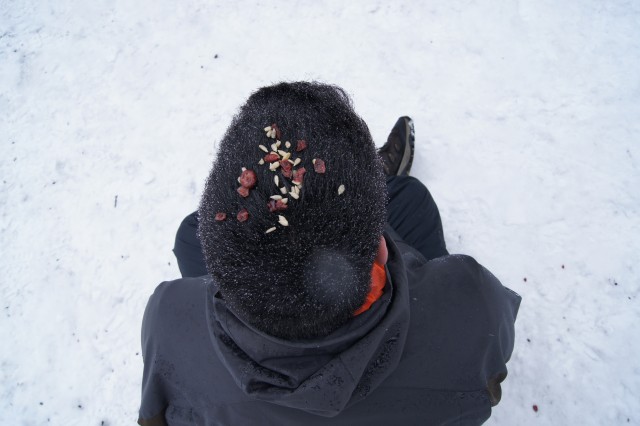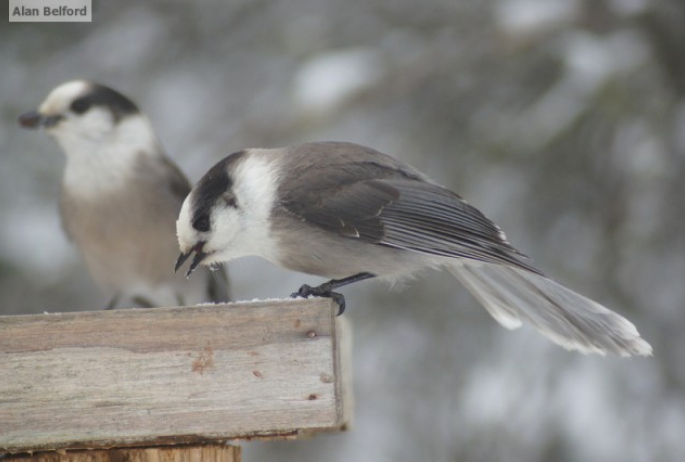The Thing Everyone Wants to Do
Whenever anyone comes to visit me in Saranac Lake there is always one thing on their to-do list: feed the Gray Jays along the Bloomingdale Bog Trail. They are a sought-after boreal species which draw many birders to our area, but more than that they are simply fun to observe. So whether it is my birding brothers looking for species they can’t find at home or my niece, nephew, and mother who want to experience the natural world up close, Gray Jays are always a priority.
Not only are Gray Jays a must on any visit, but Bloomingdale Bog is the best place to observe Gray Jays in the area, region, state, and perhaps the entire northeast! While I would never assume to use the dreaded “G” word for any species of bird when I guide or take people out – especially for a good bird which people want to see – but Bloomingdale Bog is as close to a guarantee for finding Gray Jays that I’ve seen.

That said, I have missed them on occasion, but those rare instances generally happen when I walk Wren late in the day or in the evening – in other words, when I’m not looking for them. Morning trips usually bring the birds with them. How the birds respond to visitors is another matter and far from a guarantee – sometimes they come close and other times they remain somewhat distant. Bloomingdale Bog is so good for the jays partly because birders and dog walkers regularly feed them there – meaning the birds often linger in the area and wait for passersby whom they can hit up for vittles. In fact, the jays are so approachable and accustomed to people that if you don’t see any, you should always glance over your shoulder to see if they are silently following you down the trail. While you may think you are going to the bog in order to find Gray Jays, it is generally the Gray Jays which find you.
The Debate Over Feeding Wildlife
Now, it is widely considered poor form to feed wildlife – theories suggest that wildlife which grows accustomed to human handouts may have difficulty finding their own food, and habituated animals may become nuisance individuals – trampling gardens, stealing food, or even becoming aggressive towards people. After all, most so-called problem bears become problems when we encourage them to become habituated to us and our food. We are usually to blame for their poor manners and the subsequent threat they can pose – which ultimately leads to their destruction. But it’s a stretch to call a 70g bird a threat and the worst they might do is become a nuisance in a campground where they can steal food. It is true that in some locations out west there are concerns about feeding jays (mostly Stellar’s Jays) potentially increasing their populations - the rising numbers of which may increase their predation pressure on the young of regionally uncommon bird species. But I have not heard of such concerns with Gray Jays in our region.

And so when I first went out to visit the Gray Jays myself when I moved here I didn’t feed them – wanting to be sure it wasn’t going to lead to an unforeseen problem for the jays or any other species. But I was soon converted to the activity – so many folks were already feeding the birds anyway that my abstinence accomplished nothing except to deprive myself the fun of doing so.
If You Go
If you want to see the jays yourself, start at the Route 55 entrance to the Bloomingdale Bog Trail and walk south until you reach the power line cut where a small feeding station has been created for the Gray Jays. If the jays aren’t there, keep walking and they will likely find you. Once they do hold the nuts, seed, or fruit you’ve brought (some folks use cat food) aloft on outstretched hands and wait for them to land to scoop up their meal. Sunflower seed will also trigger the local Black-capped Chickadees to do the same, but they are diminutive compared with the Gray Jays. The jays have more heft when they land on your hand and I’ve also had them land on my head when I was standing still enough not to alarm them. They are surprisingly unafraid of humans and even will land on my hand while my Labrador Retriever Wren looks on hoping for some food herself. This moxie makes them great for photos – and whether or not I bring any food I always have my camera.

At times the jays take a while to show or when they do arrive they seem to have little interest in the handouts – that may be because they have already fed well that day. This means feeding them can be an act of cold waiting during the winter, but one which quickly becomes rewarding once a jay plucks up the courage to land. The veterans find such grit quickly – the young birds in the spring seem to take more time to summon the courage and they learn by watching their parents and other adults before they follow their example. The jays will often seek a preferred food from your hand too – they like cranberries – and will stuff themselves with it before setting off with a full crop to stash their cache in the woods. Gray Jays actually create sticky saliva and can attach such prizes to trees above the snow line so they can eat them later. If you pay attention you may see Blue Jays lurking in the trees above – they won’t come to your hands – waiting to follow the Gray Jays to steal what the Grays hide.
And so as the New Year begins, I’ll be heading out to visit the Gray Jays for a photo shoot soon.
Plan your birding adventure by checking out our outdoor recreation, lodging, and dining pages here.








